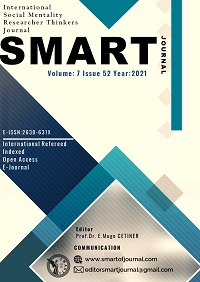BAYBURT ÜNİVERSİTESİ BEDEN EĞİTİMİ VE SPOR YÜKSEKOKULU ÖĞRENCİLERİNİN SPORTİF UYGULAMALARDA MÜZİĞİN ETKİSİ ALGILARININ İNCELENEMESİ
Author :
Abstract
Bu çalışmada; Bayburt Üniversitesi Beden Eğitimi ve Spor Yüksek Okulu Öğrencilerinin sportif uygulamalarda müziğin etkisinin incelenmesi amaçlanmıştır. Araştırma iki bölümden oluşan anket tekniği kullanılmıştır. Birinci bölümde katılımcılara demografik özelliklerinin sorulduğu sorular kullanıldı. İkinci bölümde, Karayol ve Turhan (2020) tarafından geliştirilen, sportif uygulamalarda müziğin etkisini ölçmeye yarayan “SUMEÖ” toplam 18 maddeden ve 3 alt boyuttan oluşup 5’li Likert biçiminde oluşan ölçek kullanıldı. Toplam Alpha Katsayısı=0,0885 olarak bunlunmuş. Veri toplama araçları, Bayburt Üniversitesi Beden Eğitimim ve Spor Yüksek Okulu öğrencileri oluştururken, örneklem grubunu ise 321’i erkek, 243’ü kadın olmak üzere toplam 564 katılımcıya uygulanmıştır. Yapılan analizler sonucunda, sportif uygulamalarda müziğin etkisi algılarının cinsiyet değişkenine (p=,001*) göre alt boyutlarda ve toplam puanda farklılaştığı tespit edilmiştir. Spor süresi değişkeni (p=,174) açısından ise, herhangi bir anlamlılığa sahip olmadığı belirlenmiştir
Keywords
Abstract
In this study; Bayburt University School of Physical Education and Sports Students aimed to examine the effect of music in sporting applications. The survey technique consisting of two sections of the research was used. In the first part, questions were used in which participants were asked about their demographic characteristics. In the second part, the “SUMEÖ” scale developed by Karayol and Turhan (2020), which is used to measure the effect of music in sports applications, consisting of a total of 18 substances and 3 sub-dimensions and consisting of 5 Likert forms, was used. Total Alpha Coefficient=0.0885. Data collection tools were applied to the students of Bayburt University School of Physical Education and Sports, while the sample group was applied to a total of 564 participants, 321 males and 243 females. As a result of the analysis, it was determined that the perception of the effect of music in sports applications differed in lower dimensions and total score according to gender change (p=, 001*). In terms of sports duration variable (p=,174), it was determined that it did not have any significantness.
Keywords
- Arslan, H. (2015). Müzik Terapi ve Dini Müzik. Hikmet Yurdu Düşünce-Yorum. Sosyal Bilimler Araştırma
- Arslan, H. (2015). Müzik Terapi ve Dini Müzik. Hikmet Yurdu Düşünce-Yorum. Sosyal Bilimler Araştırma Dergisi, 8(16), 103-127.
- Bayram, M., Aka, S. T., Geçit, M. S., & Şebin, K. (2019). İslam’da Sporun Önemi Ve Ahlakı. Ağrı İbrahim Çeçen Üniversitesi Sosyal Bilimler Enstitüsü Dergisi, 5(1), 207-224.
- Bompa, T. O. (1998). Therory and Methodlogy of Traning (Çeviren İ. Keskin, AB Tunur). Bağırgan Yayınevi, Ankara.
- Erdal, G. (2005). Sporda Performansın Artırılmasında Müziğin Etkisi. 4. Ulusal Beden Eğitimi ve Spor Öğretmenliği Sempozyumu, 10-11.
- Erkan, E. (1992). Toplum Sağlığı Açısından Spor. Editör: Ergen E, TTB Merkezi Konseyi Spor Hekimliği Kolu Yayın, (1).
- Haluk, K., Turchian, C., & Adnan, C. (2009). Influence Of Musıc On Wıngate Anaerobıc Test Performance. Ovidius University Annals, Series Physical Education & Sport/Science, Movement & Health, 9(2).
- Kalender, R. (1989). Ruh Hastalıkları Tedavisinde Musiki.
- Kartal, A., & Ergin, E. (2018). Dinlenilen farklı tempo müziklerin futbolcularda aerobik ve anaerobik performansa etkisinin incelenmesi. Spormetre, 16(3),149-157 DOI: 10.1501/Sporm_0000000383
- Kat, H. (2009). Bireysel Sporcularla Takım Sporcularının Stres Düzeyleri Ve Problem Çözme BecerilerininKarşılaştırılması. Yayımlanmamış Yüksek Lisans Tezi, Kayseri: Erciyes Üniversitesi Sağlık Bilimleri Enstitüsü.
- Koç, H., Curtseit, T., & Mamak, H. (2011). Submaksimal Efor Sırasında Farklı Tip Müziğin Bazı Fizyolojik Parametreler Üzerine Etkisi. Türk Spor ve Egzersiz Dergisi, 13(2), 211-215.
- Kravitz, L. (1994). The Effects Of Music On Exercise. Idea Today, 12(9), 56-61.
- Matesic, B. C., & Cromartie, F. (2002). Effects Music Has On Lap Pace, Heart Rate, And Perceived Exertion Rate During A 20-Minute Self-Paced Run. The sport journal, 5(1).
- Mavi, S. (2012). Hızlı Tempo Müziğin Taekwondocular Üzerindeki Etkileri (Doctoral dissertation, Yüksek Lisans Tezi, Anakara Üniversitesi Sağlık Bilimleri Enstitüsü. Ankara).
- Önsü, A. (2005). Müzikle Yapılan Egzersizlerin Sürekli Kaygıya Etkisi Ve Bu Etkinin Beyin Dalgalarıyla Desteklenmesi (Master's thesis, Kocaeli Universitesi, Saglik Bilimleri Enstitusu).
- Özdevecioğlu, M., & Yalçın, Y. (2010). Spor Tatmininin Sporcuların Stres Ve Saldırganlık Düzeyleri Üzerindeki Etkisi. Beden Eğitimi ve Spor Bilimleri Dergisi, 4(1), 63-76.
- Özkan, R. (2011). Genel ve İmam Hatip Lisesi öğrencilerinin beden eğitimi ve spor dersine ilişkintutumlarının karşılaştırılması. Doctoral dissertation, Yüksek Lisans Tezi. Gazi Üniversitesi Sağlık Bilimleri Enstitüsü. Ankara.
- Soyer, F., Yusuf, C., & Türkel, Ç. (2010). İlköğretim Çağı Öğrencilerinin Sportif Faaliyetlere KatılımDüzeyi İle İletişim Beceri Düzeyleri Arasındaki İlişkilerin İncelenmesi. Sakarya Üniversitesi Eğitim Fakültesi Dergisi, (19), 73-88.
- Stevens, M.J., Lane, A.M. (2001). Mood-Regulating Strategies Used By Athletes, Athletic Inside, The Online Journal of Sport Pychology, 3: 3-10.
- Sunay, H. (2002). Türkiye’de Sporun Yaygınlaştırılması Kapsamında Çağdaş Spor Yöneticilerinin Rolü ve Önemi. 7. Uluslararası Spor Bilimleri Kongresi Özet Kitabı, Antalya, 263-72.
- Szabo A., Balogh L., Gaspar Z., Vaczi M., Bösze J. (2009): The Effects of Fast and Slow Tempo Music On Recreational Basketball Players. International Quarterly of Sport Science. 2, 2-13.
- Uluışık, V., & Pepe, K. (2015). ’Spor Yapan ve Yapmayan Ortaöğretim Öğrencilerinin Stres ve Saldırganlık Düzeylerinin İncelenmesi’. Uluslararası Spor Bilimleri Dergisi, 1(1), 1-13.
- Uslu, M. (2007). Çocuklarda ve gençlerde müzik eğitiminin önemi üzerine bir değerlendirme. Müzik ve Bilim “Uluslararası Hakemli Bilimsel Müzik Dergisi, (7).
- Tabachnick, B. G. And Fidell, L. S. (2013). Using multivariate statistics. Boston, Pearson.
- Vatansever, S., ŞAHİN, Ş., AKALP, K., & ŞENTÜRK, F. C. (2018). Müziğin Maksimal KoşuPerformansına Ve Egzersiz Sonrası Toparlanma Hızına Etkisi. Türkiye Spor Bilimleri Dergisi, 2(2), 61-66. Voigt, D., & Atalay, A. (1998). Spor sosyolojisi. Alkım Yayınları.
- Yazarer, İ., Taşmektepligil, M. Y., Ağaoğlu, Y. S., & Ağaoğlu, S. A. (2004). Yaz Spor OkullarındaBasketbol Çalışmalarına Katılan Grupların İki Aylık Gelişmelerinin Fiziksel Yönden Değerlendirilmesi. Spormetre Beden Eğitimi ve Spor Bilimleri Dergisi, 2(4), 163-170.
- Yıldırım, Y. Y., & Sunay, H. T. D. (2009). Türkiye'de Performans Tenisi Yapan Sporcuların Tenise BaşlamaNedenleri Ve Beklentileri (Doctoral dissertation, Ankara Üniversitesi Sağlık Bilimleri Enstitüsü Beden Eğitimi ve Spor Bilimleri Anabilim Dalı).
- https://www.tdk.gov.tr/tdk/kurumsal/yazim-kilavuzu/ Erişim 29.01.2021.
